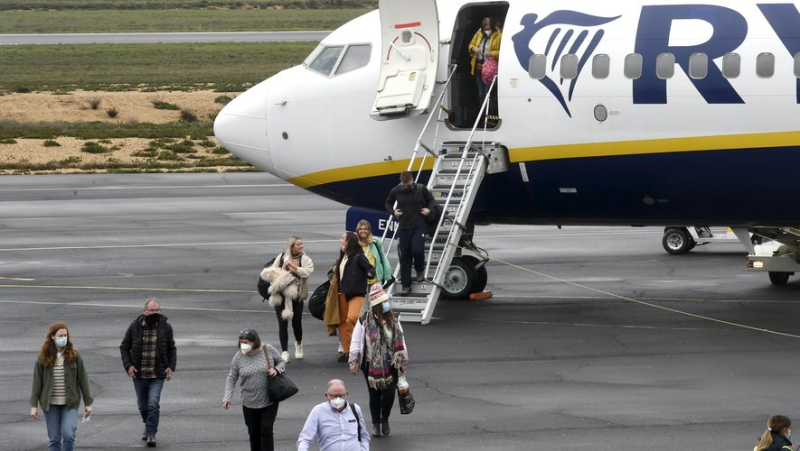Consequence of Air France's decline: low-cost airlines drive the dynamics of regional airports

Landing of a Ryanair flight at Béziers-Cap d’Agde airport. All commercial flights are operated by the Irish low cost airline. Midi Libre – SYLVIE CAMBON
The weight of low cost in French traffic continues to grow. In 2023, they will account for 43.2% of global traffic, according to figures from the Union of French Airports (UAF). In 2019, it was 35%. And the airports of the former Languedoc Roussillon are not immune to this momentum.
"After three years of difficulties linked to the COVID-19 crisis, traffic still remains below its 2019 level". In its report for the year 2023, published a few days ago, the Union of French Airports (UAF) notes that with 198 680 952 commercial passengers, the traffic recorded in 2023 remains "down by only 7.3 % compared to 2019". However, the dynamic is definitely back. The increase in traffic compared to 2022 is 14.2%, , or nearly 25 million additional commercial passengers.

The weight of low-cost (or low-cost) airlines in regional airport traffic. It is important.
This dynamic is due to a particularly healthy market, that of flights operated by low-cost companies. They are the ones who truly support national airports. "Low cost traffic now represents 43.2 % of traffic in mainland France, or more than 80 million passengers, while it represented 35 nbsp;% of traffic in 2019", specifies the UAF. It has "amply exceeded its 2019 level (+13.8 %)", while traditional traffic "has not completed catching up to its pre-Covid" level, with 80.8& nbsp;% of its 2019 level.
"Low cost provides access to mobility"
The excellent dynamic of low-cost airlines is also felt in the activity of airports in the former Languedoc Roussillon. Particularly those which, like Nîmes, Béziers or Carcassonne, owe their good health only to that of their main airline partner, Ryanair. And as Ryanair's health is at its zenith… "As we are the territory furthest from the capital, Paris, the plane is the most useful way to open it up, comments Christophe Manas, regional councilor and president of the Regional Public Airport Local Company (SPLAR), which manages the Carcassonne and Perpignan airports. Low cost are today at reasonable costs, they allow access to mobility.
In France, three airports have traffic provided at more than 99% by low-cost airlines: Carcassonne Sud de France, Paris-Beauvais and Béziers &ndash ; Cap d’Agde Hérault Occitanie. "Without low cost, we would be more of an airport with a different activity, we would be public service",notes Isabelle Roumagnou, director of the Biter airport platform. With 273, 297 passengers welcomed in 2023, the latter has broken a new traffic record. Thanks to its routes almost entirely operated by Ryanair, Béziers Cap d’Agde airport has caught up with its activity rate recorded before the Covid-19 health crisis.
"When you are in the provinces, these are the ones you have to look for"
Since the arrival of Franck Proust at the head of Nîmes Métropole, in charge of the development of the Gard airport, the latter has been committed to a new ambition. And here again, it goes through low cost. "These companies are those which have the largest number of aircraft and which are ready to open new markets, explains Gilles Tellier, his new director. They become essential for any airport wishing to develop.
“We must diversify the nature of carriers”
All those responsible for ensuring the smooth running of the region's airports are aware of this: excessive dependence on a single low-cost airline should be avoided. "We are doing everything we can to diversify the nature of air carriers present in Nîmes and attract new companies to more incoming destinations » ; in order to promote tourism with high added value for the territory, says Gilles Tellier, who directs that of Nîmes. "There are today, in Europe, only four low-cost airlines that count: Transavia, Ryanair, easyJet and Volotea. They account for 90% of the growth. You have to have as many as possible", adds Emmanuel Brehmer, who directs the one in Montpellier. Knowing that Ryanair has not been operating there for several years, following a dispute over the amount of financial aid provided. Because this is the primary risk of regional airports: being too dependent on a single company. About ten years ago, Montpellier began its diversification. What about the others ?
"Given the reduction of beams on Paris-Orly (by the Air France-KLM group, Editor's note), we do not have “other choices than developing low cost traffic, insists Emmanuel Brehmer, boss of Montpellier Méditerranée airport. Four years ago, they represented 40% of our traffic. Today, it’s 65%". He adds: "when you are a provincial airport, these are the ones you have to look for".
I subscribe to read more




